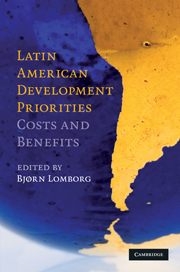Book contents
- Frontmatter
- Contents
- List of figures
- List of tables
- List of contributors
- Acknowledgments
- Abbreviations and acronyms
- Expert panel findings
- Introduction
- Democracy
- Education
- 2 Three proposals to improve education in the LAC region: estimates of the costs and benefits of each strategy
- 2.1 Education: an alternative view
- Employment and social security
- Environment
- Fiscal problems
- Health
- Infrastructure
- Poverty
- Public administration
- Violence and crime
- Conclusion
- References
2.1 - Education: an alternative view
Published online by Cambridge University Press: 05 June 2012
- Frontmatter
- Contents
- List of figures
- List of tables
- List of contributors
- Acknowledgments
- Abbreviations and acronyms
- Expert panel findings
- Introduction
- Democracy
- Education
- 2 Three proposals to improve education in the LAC region: estimates of the costs and benefits of each strategy
- 2.1 Education: an alternative view
- Employment and social security
- Environment
- Fiscal problems
- Health
- Infrastructure
- Poverty
- Public administration
- Violence and crime
- Conclusion
- References
Summary
In their Solution chapter, Damon and Glewwe present a useful summary of options to improve education in the LAC region. This alternative view presents three comments. The first simply seeks to complement the authors' sound diagnosis, making the case that while they are correct to emphasize educational quality, some issues concerning quantity remain. Specifically, achieving acceptable enrollment and particularly grade completion rates is still a challenge in many countries, which reflects issues related to delayed entry, drop-out, and repetition rates.
The second comment arises because the Consulta de San José takes the interesting approach of comparing interventions across sectors, which necessitates the calculation of BCRs. Damon and Glewwe note that this in turn requires knowledge of interventions' causal impact. They therefore reasonably choose to focus on “interventions that have been rigorously evaluated,” and use an appropriately high standard to select them. This gives the chapter a sharp focus but entails a cost, because the menu of options considered must originate from a limited list – excluding, for instance, some options to reduce repetition or raise school quality.
The final comment concerns the chapter's third proposal: school choice. One point here is that this is not a clearly defined option – the term can stand for different interventions with potentially different results.
- Type
- Chapter
- Information
- Latin American Development PrioritiesCosts and Benefits, pp. 92 - 102Publisher: Cambridge University PressPrint publication year: 2010



